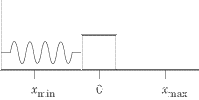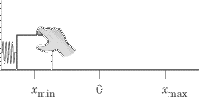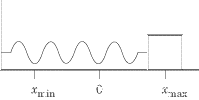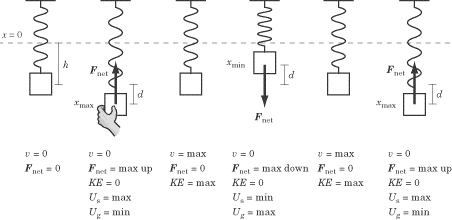The Oscillation of a Spring
. To start with, we’ll imagine a mass,m, placed on a frictionless surface, and attached to a wall by a spring. In its equilibrium position, where no forces act upon it, the mass is at rest. Let’s label this equilibrium positionx=0. Intuitively, you know that if you compress or stretch out the spring it will begin to oscillate.
Suppose you push the mass toward the wall, compressing the spring, until the mass is in position

.
When you release the mass, the spring will exert a force, pushing the mass back until it reaches position

, which is called the
amplitudeof the spring’s motion, or the maximum displacement of the oscillator. Note that

.
By that point, the spring will be stretched out, and will be exerting a force to pull the mass back in toward the wall. Because we are dealing with an idealized frictionless surface, the mass will not be slowed by the force of friction, and will oscillate back and forth repeatedly between

and

.
Simple Harmonic Oscillation
A mass oscillating on a spring is one example of asimple harmonic oscillator. Specifically, a simple harmonic oscillator is any object that moves about a stable equilibrium point and experiences a restoring force proportional to the oscillator’s displacement.
For an oscillating spring, the restoring force, and consequently the acceleration, are greatest and positive at

. These quantities decrease as
xapproaches the equilibrium position and are zero at
x=
0. The restoring force and acceleration—which are now negative—increase in magnitude as
xapproaches

and are maximally negative at

.
Period of Oscillation
The period of oscillation,T, of a spring is the amount of time it takes for a spring to complete a round-trip or cycle. Mathematically, the period of oscillation of a simple harmonic oscillator described by Hooke’s Law is:
This equation tells us that as the mass of the block,m, increases and the spring constant,k, decreases, the period increases. In other words, a heavy mass attached to an easily stretched spring will oscillate back and forth very slowly, while a light mass attached to a resistant spring will oscillate back and forth very quickly.
Frequency
The frequency of the spring’s motion tells us how quickly the object is oscillating, or how many cycles it completes in a given timeframe. Frequency is inversely proportional to period:
Frequency is given in units of cycles per second, or hertz (Hz).
Potential Energy
The potential energy of a spring (

) is sometimes called elastic energy, because it results from the spring being stretched or compressed. Mathematically,

is defined by:
The potential energy of a spring is greatest when the coil is maximally compressed or stretched, and is zero at the equilibrium position.
Kinetic Energy
At the points of maximum compression and extension, the velocity, and hence the kinetic energy, is zero and the mechanical energy is equal to the potential energy,
Us=1/2
.
At the equilibrium position, the potential energy is zero, and the velocity and kinetic energy are maximized. The kinetic energy at the equilibrium position is equal to the mechanical energy:
From this equation, we can derive the maximum velocity:
You won’t need to know this equation, but it might be valuable to note that the velocity increases with a large displacement, a resistant spring, and a small mass.
In this figure,
vrepresents velocity,
Frepresents force,
KErepresents kinetic energy, and

represents potential energy.
Vertical Oscillation of Springs
The oscillation of the spring when compressed or extended won’t be any different, but we now have to take gravity into account.
Equilibrium Position
Because the mass will exert a gravitational force to stretch the spring downward a bit, the equilibrium position will no longer be atx=0, but atx = –h, wherehis the vertical displacement of the spring due to the gravitational pull exerted on the mass. The equilibrium position is the point where the net force acting on the mass is zero; in other words, the point where the upward restoring force of the spring is equal to the downward gravitational force of the mass.
Combining the restoring force,F= –kh, and the gravitational force,F=mg, we can solve forh:
Sincemis in the numerator andkin the denominator of the fraction, the mass displaces itself more if it has a large weight and is suspended from a lax spring, as intuition suggests.
A Vertical Spring in Motion
If the spring is then stretched a distance
d, where
d<
h, it will oscillate between

and

.
Throughout the motion of the mass, the force of gravity is constant and downward. The restoring force of the spring is always upward, because even at

the mass is below the spring’s initial equilibrium position of
x=
0. Note that if
dwere greater than
h,

would be above
x=
0, and the restoring force would act in the downward direction until the mass descended once more below
x=
0.
According to Hooke’s Law, the restoring force decreases in magnitude as the spring is compressed. Consequently, the net force downward is greatest at

and the net force upward is greatest at

.
Energy
The mechanical energy of the vertically oscillating spring is:
where

is gravitational potential energy and

is the spring’s (elastic) potential energy.
Note that the velocity of the block is zero at

and

, and maximized at the equilibrium position,
x = –h. Consequently, the kinetic energy of the spring is zero for

and

and is greatest at
x = –h. The gravitational potential energy of the system increases with the height of the mass. The elastic potential energy of the spring is greatest when the spring is maximally extended at

and decreases with the extension of the spring.











 .
.
 , which is called the
, which is called the .
.
 and
and .
. . These quantities decrease as
. These quantities decrease as and are maximally negative at
and are maximally negative at .
.

 ) is sometimes called elastic energy, because it results from the spring being stretched or compressed. Mathematically,
) is sometimes called elastic energy, because it results from the spring being stretched or compressed. Mathematically, is defined by:
is defined by:




 represents potential energy.
represents potential energy.

 and
and .
.
 the mass is below the spring’s initial equilibrium position of
the mass is below the spring’s initial equilibrium position of would be above
would be above and the net force upward is greatest at
and the net force upward is greatest at .
.
 is gravitational potential energy and
is gravitational potential energy and is the spring’s (elastic) potential energy.
is the spring’s (elastic) potential energy. and
and , and maximized at the equilibrium position,
, and maximized at the equilibrium position, and
and and is greatest at
and is greatest at and decreases with the extension of the spring.
and decreases with the extension of the spring.



